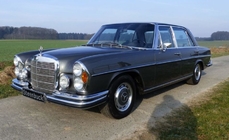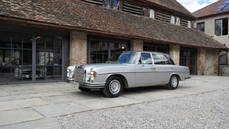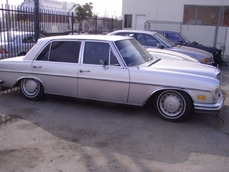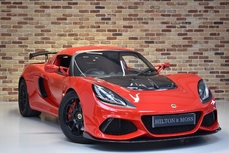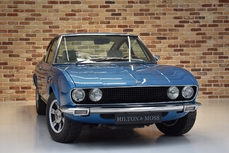Mercedes-Benz 300SEL 6.3 w109 1972
General description :
The Mercedes-Benz 300 SEL 6.3 was a luxury performance car built by Mercedes Benz from 1968 to 1972. It featured the company’s powerful legendary 6.3-litre M100 V8 from the luxurious 600 limousine installed in the normally six-cylinder powered Mercedes Benz 300 SEL. The result was a nearly 2-tonne saloon with performance similar to most dedicated sports cars and American muscle cars of the era. At the time of its release it was the world’s fastest four door car, sprinting to 60 mph in just 6.5 seconds. The Model was in essence the “Genesis” for the super saloon we know today – think AMG, BMW M5, Lotus Carlton etc – would they have existed if the 6.3 w109 was not put into production? Possibly not.The model was also famed as a short lived but successful racer of the time, with the now infamous “red-pig” AMG campaigned car competing at the 1971 Spa 24 hour race with prodigious pace – finishing 2nd – yes a 4 door Mercedes saloon! The model that effectively gave birth to AMG as we know it today, the quintessential iron fist in a velvet glove!Here we offer a very rare RHD UK supplied car of just 500 believed to have been supplied for the UK market. This car is also an sunroof car which is even rarer, and being registered in 1972 is one of the very last of this cult model. This is probably one of the best surviving unrestored examples ever to come available, having spent a large amount of its life in dry storage. Most commonly produced in 180g silver, it is very very rare to see a w109 6.3 in this colour, db387 lapis blue poly metallic– and my goodness does it suit the car well. With a charmingly worn interior that has no rips or tears, just a little fading to its blue “pullman” velour, we are loathed to retrim the car as it would almost detract from the original survivor nature of this big blue brute. It really is a charmingly patinated example which is far more characterful than a freshly restored example. They are only original once as they say….
Supplied by Mercedes-Benz of Surrey (Walton Motors LTD, Walton on Thames) on 3rd February 1972, the car was clearly enjoyed extensively straight away, accruing 20,000 miles in the first year, and a further 15,000 in the next year. Regular use and scheduled main dealer servicing continued and a new owner was registered to the car, in the Nottingham area in 1981. An MOT from 1982 shows the odometer reading at 91k and some 27 years later the odometer now only reads 94k and as such you can see that the car has hardly been used in the last 3 decades. The second owner kept the car for over 20 years up to 2003 where due to lack of use from its elderly owner, the car was moved on.The most recent owner of the car from 2003 until we acquired the vehicle late last year, was again from the Nottingham area and he kept the car in dry storage almost continually, aiming to preserve its condition as a very original and unmolested car, his absolute pride and joy and that owning and preserving the car was more than enough pleasure than driving her very much.
Having seen very little use for nearly 40 years the car has been preserved so well, wearing almost entirely original paintwork, the car just stands out as a survivor car that has escaped having much work done at all besides regular servicing and maintenance. Coming with a fabulous 5 digit number plate that is also very valuable, this is a wonderful example, in rare spec of a cult performance car that really is the ultimate “Jekyll and hyde” sleeper.
The legendary M100 engine runs so well and has recently received a full lubrication service. The air suspension holds pressure perfectly and rises and lowers on demand the way it should. We have checked over the entire system in our workshop resulting in a light overhaul and the addition of new rear shock absorbers. It drives very very well and any petrol head should really experience one of these bests at some point in their life. This is a fantastic rare Mercedes with original handbooks and manuals, and lovely original features like the tool kit, jack and brace, plus period 1980’s MB valeting kits / first aid kits in their original cases. The car even has an unused and oh so 80’s “feu orange” traffic lights air freshener! Sitting in the car is like being taken back in time!
With values on the rise, this rare flagship example represents a fantastic opportunity to acquire a very fine example of a car already achieving heady heights value wise and only set to continue to increase. This is a seriously rare car and a rare opportunity at a relatively affordable price.Please speak to a member of the team for details.
https://hiltonandmoss.com/cars/mercedes-benz-s-class-2/
1972 Mercedes-Benz 300SEL 6.3 w109 is listed sold on ClassicDigest in Stansted by Hilton Moss for £57950.
Car Facts
Car type : Car Make : Mercedes-Benz Model : 300SEL 6.3 w109 Engine size : 6.3 Model Year : 1972 Location : Stansted
Sold
Seller Information
Sold
People who viewed this Mercedes-Benz 300SEL 6.3 w109 also viewed similar Mercedes-Benz listed at ClassicDigest
Other cars listed for sale by this dealer
About Mercedes-Benz
In the annals of automotive history, the journey of Mercedes-Benz is a tale that unfolds with the ingenuity of its founding pioneers. In the year 1886, Karl Benz crafted the Benz Patent Motorwagen, a creation that would go down in history as the world's inaugural automobile. Unbeknownst to him, this moment marked the genesis of what would evolve into the most illustrious premium car manufacturer globally. The financial underpinning of this pioneering venture, interestingly, was provided by Karl Benz's wife, Bertha Benz, demonstrating a remarkable partnership that would set the tone for Mercedes-Benz's legacy.A parallel narrative emerged not far away, as Daimler-Motoren-Gesellschaft, founded by Gottlieb Daimler and Wilhelm Maybach, entered the scene. In 1901, they unveiled their automobile under the now-famous moniker "Mercedes," meaning "godsend" in Spanish. This name was bestowed upon the car at the behest of Emil Jellinek's daughter, the distributor for Daimler-Motoren-Gesellschaft. The wheels of innovation were set in motion.
Fast forward to 1926, a pivotal year that witnessed the merger of Daimler with Benz & Cie., culminating in the birth of Daimler-Benz. The amalgamation saw the adoption of "Mercedes-Benz" as the distinguished trademark for their automobiles, fusing the legacies of two visionary entities into one.
Contrary to perceptions of conservatism, the trajectory of Daimler-Benz unfolds as a chronicle of industry firsts. From the introduction of the honeycomb radiator to the float carburetor, and the pioneering implementation of four-wheel brakes in 1924, Daimler-Benz consistently pushed the boundaries of automotive innovation. The diesel-powered Mercedes-Benz 260 D in 1936 marked the inception of diesel engines in passenger cars. The iconic Mercedes-Benz 300SL Gullwing made history as the first car with direct fuel injection, albeit the Gutbrod's tiny 2-stroke engine can claim precedence.
Safety innovations became a hallmark, with Béla Barényi's patented safety cell design in the "Ponton"-models in 1951, featuring front and rear crumple zones. The W116 450SEL 6.9 saw the introduction of the Anti-Lock Brake system (ABS), another pioneering safety feature. From the first production airbags and beyond, the legacy of "firsts" continued to be etched into the fabric of Daimler-Benz.
Over its centennial journey, Mercedes-Benz has not merely produced cars but has sculpted automotive icons. The SSKL, 710 SSK Trossi Roadster, 770K Grosser, 540K Spezial Roadster, 300SL Gullwing, w100 600 Pullman, w111 280SE 3.5 Flachkühler, w113 230SL Pagoda, w109 300 SEL 6.3, and w201 2.3-16 Cosworth stand testament to the brand's commitment to engineering excellence.
The roaring Silver Arrows, or "Silberpfeile," including the W 25, W 125, W154, W165, and W196, created a legacy of dominance on the racetrack. These machines were not merely cars; they were expressions of precision, speed, and an indomitable spirit that left their competitors in the dust.
As Mercedes-Benz marches into the future, it does so not just as an automaker but as a custodian of a legacy, a torchbearer of innovation, and a beacon of automotive excellence. The road ahead is sure to witness the continued fusion of cutting-edge technology, timeless design, and an unwavering commitment to setting new standards in the world of automobiles.
One luminary figure who left an indelible mark was Béla Barényi, often heralded as the "father of passive safety" for his pioneering work in safety engineering. His patented safety cell design, featuring front and rear crumple zones, became a hallmark of Mercedes-Benz's commitment to occupant safety, setting new standards that reverberated throughout the automotive world.
Moving through the chronicles, the collaborative genius of Wilhelm Maybach, alongside Gottlieb Daimler, laid the foundation for Daimler-Motoren-Gesellschaft. Their innovations not only birthed the first Mercedes but established a culture of relentless pursuit of technological excellence that remains integral to Mercedes-Benz's DNA.
In the post-merger era of 1926, Ferdinand Porsche emerged as a prominent figure within Mercedes-Benz. His work on the Mercedes-Benz S-Type, a supercharged race car, garnered acclaim and set the stage for a legacy that extended far beyond the marque. Porsche's impact would later extend to his eponymous company, but his influence at Mercedes-Benz during those formative years was pivotal.
As the 20th century progressed, the legendary Rudolf Uhlenhaut emerged as a key figure. Uhlenhaut, an accomplished engineer and the driving force behind the iconic Silver Arrows, played a crucial role in Mercedes-Benz's dominance in motorsports. His engineering prowess and attention to detail were instrumental in creating some of the most formidable racing cars of the era.
In the latter half of the century, figures like Bruno Sacco, the head of design at Mercedes-Benz from 1975 to 1999, left an indelible imprint on the brand's aesthetic identity. Sacco's design philosophy, characterized by clean lines and timeless elegance, shaped iconic models like the W126 S-Class and the W201 190E, solidifying Mercedes-Benz's reputation for luxury and sophistication.
The narrative would be incomplete without acknowledging the contributions of engineers like Hans Scherenberg, whose leadership in the 1970s ushered in a new era of technological innovation at Mercedes-Benz. Scherenberg's tenure saw the development of groundbreaking technologies, including the Anti-Lock Brake system (ABS) and the introduction of airbags in production cars.




